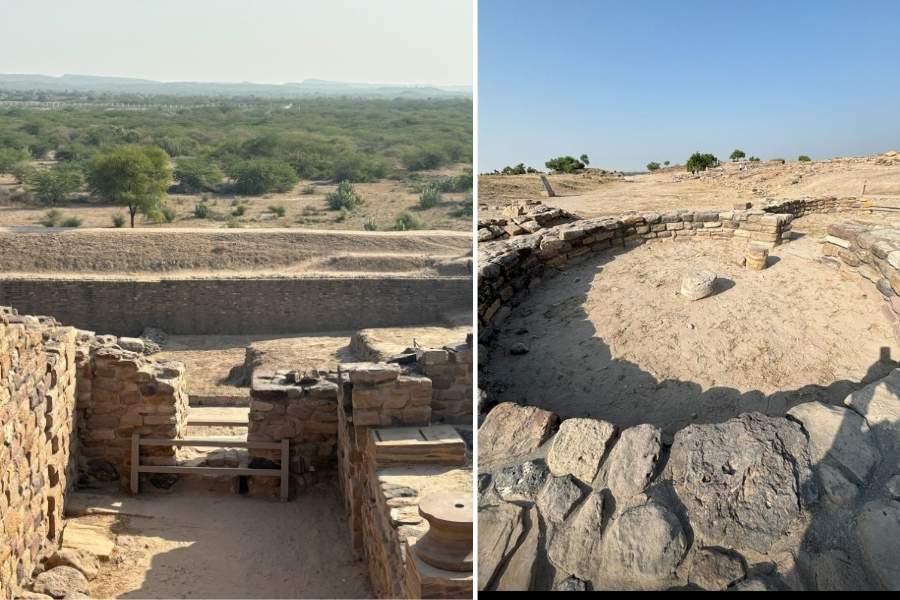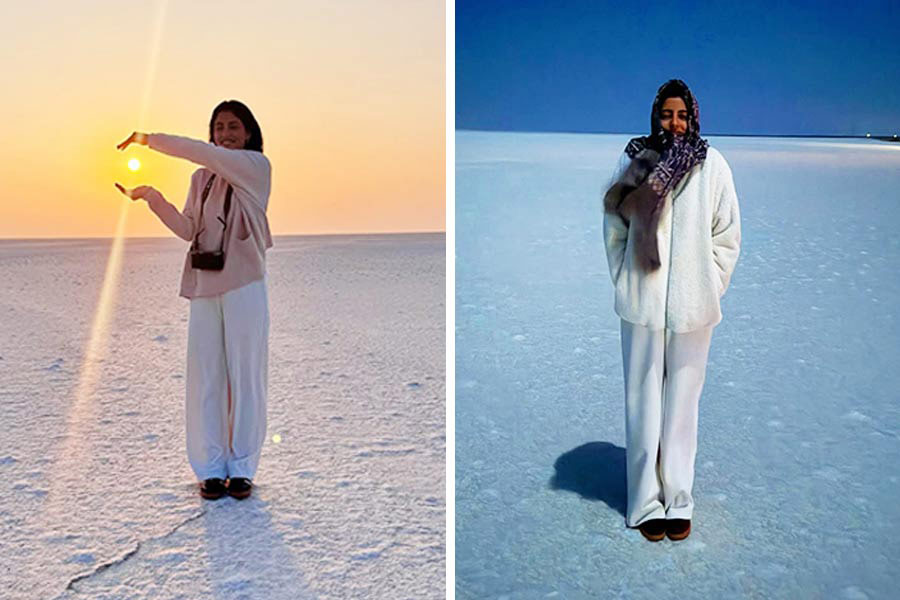A steep citadel of stone rose above me — the dusty path I walked on was lined with shrubs and thorny acacias, offering no hint of the magnificent sights ahead. I found myself in Dholavira on Khadir Bet island in Kutch, Gujarat, India. The village of Dholavira, named after one of the five largest excavated Harappan sites, spans over 100 hectares and lies on the Tropic of Cancer. Locals refer to it as Kotada Timba, meaning ‘large fort’. To reach here, we drove along the stark asphalt ‘Road to Heaven’ from Khavda — flanked by the unique white salt desert of the Great Rann of Kutch.
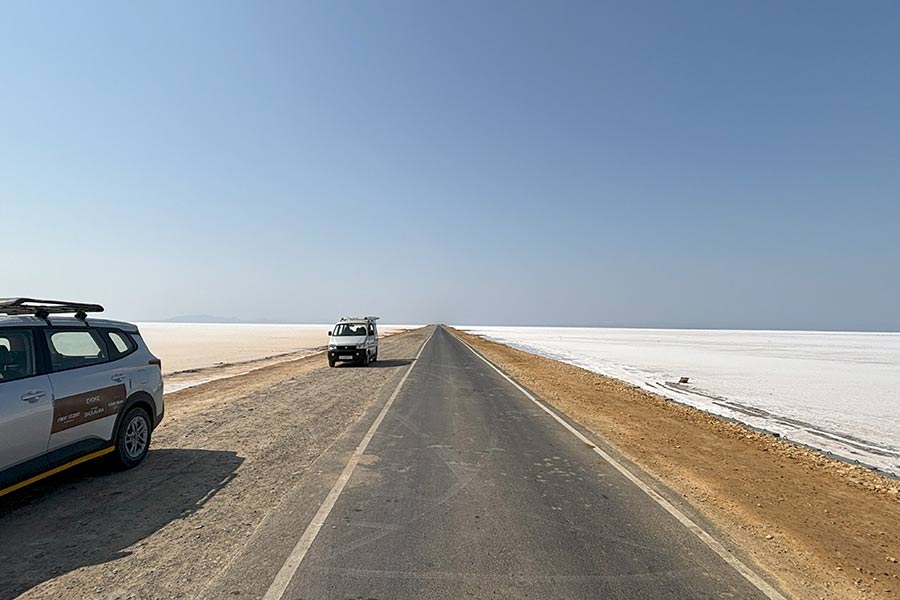
Road to heaven — from Khavda to Dholavira
I decided to stay at Evoke Dholavira, a new luxury property themed around the excavation site. Terracotta replicas of seals and artifacts found on-site adorned the property. Not far from here is the White Rann Tent City, which offers luxurious glamping inspired by the excavation site. Giant sculptures and Harappan seals decorate the area, creating an immersive experience with cultural performances, Gujarati cuisine, craft stalls, and guided trips to the archaeological site. Thanks to the four-month-long Rann Utsav, visiting Dholavira has become easier.

Glimpses of Evoke Dholavira, a new luxury property themed around the excavation site of Dholavira
The on-site Dholavira Museum is a must-visit before exploring the quadrangular site. Though small, it provides insight into the advanced civilisation and its artistic culture, showcasing terracotta seals, pottery and tools. Excavations have brought to light animal bones, gold, silver, terracotta ornaments, pottery and bronze vessels, indicating that the city was once an important trade center. The museum also displays game boards carved on pieces of rock, children’s toys, and small weights and measures.
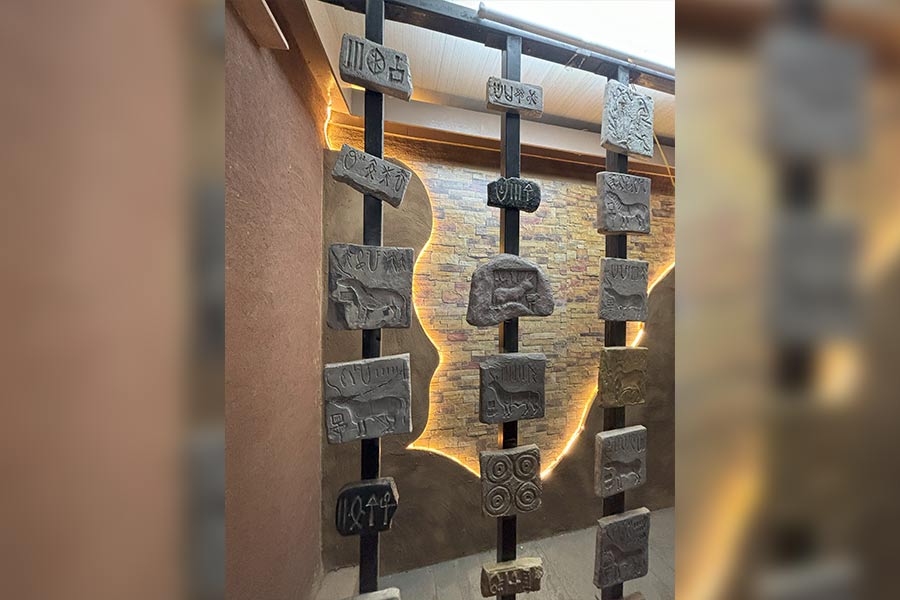
Seals with symbols displayed at the on-site museum
“Dholavira is unique in that it shows 1,500 years of continuous occupation and extraordinary skills in sustainable water management, where not a single drop of water was wasted,” says my local guide, Mahendr Sanjot.
Its discovery reads like a detective thriller — it all started in the 1960s when a local farmer found broken seals and terracotta pieces while farming. Excavations were carried out by the ASI in stages over 13 seasons, from 1990 to 2005, under the direction of Ravindra Singh Bisht. The entire village was involved in the site, as seen in vintage black-and-white photographs of village women in sarees digging the trenches.
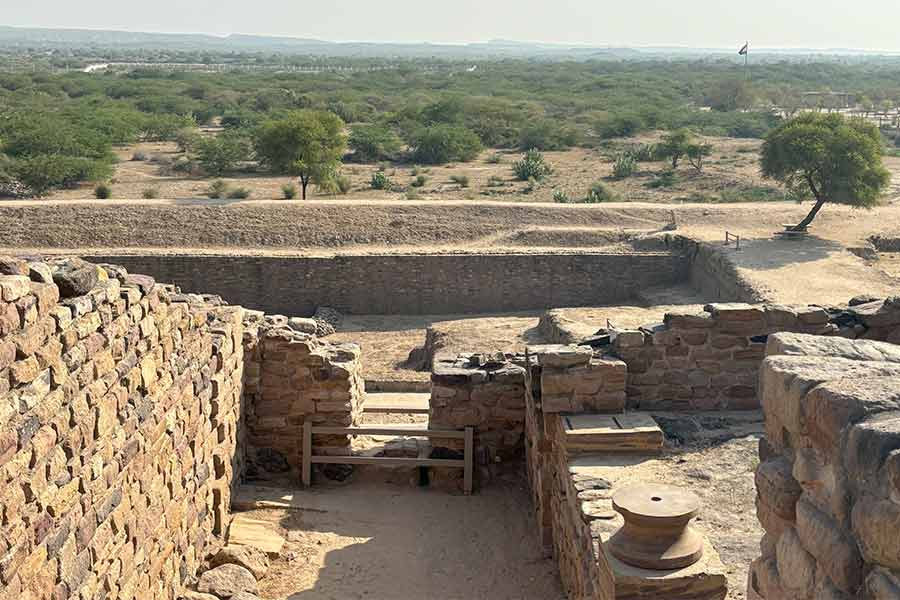
One of the largest surviving gates on the site
As we entered the site, with a swirl of dust in the air, the first thing that caught our eye was a sophisticated stone wall and a reservoir built on a stone bed, with stairs for cleaning and a recharge well inside. “They had an advanced water management system, with 10% of the city’s area set aside for a cascading system of reservoirs with stone beds — partly mason-made — and check dams. Water in this region was scarce, with no permanent rivers, and the city was surrounded by the sea and salty water. This system was fed by aqueducts,” explained Sanjot.
It’s poignant to see traces of earthen pots embedded on the steps of one reservoir. I think of women in veils, in the ancient past, stooping to collect water in mud pots. This site was destroyed and rebuilt as many as seven times—perhaps alternating cycles of flood and drought forced people in and out, but they always migrated back here.
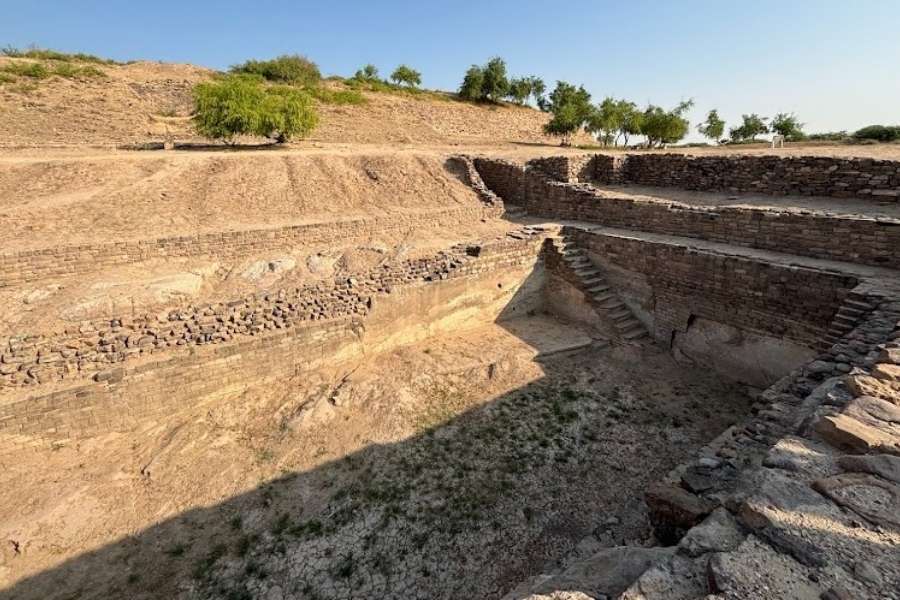
A sophisticated stone wall and a reservoir built on a stone bed, with stairs for cleaning and a recharge well inside
One of the major differences at this site is the use of sandstone and limestone from local quarries, which were resistant to weathering, as opposed to brick and mud used in other Harappan cities. The site, laid out with geometric precision, is located on three levels, suggesting a social hierarchy.
We started exploring the citadel at the highest gradient, with its fortified walls, reservoirs, and wells, as well as as many as 17 gates to the city. Strong walls still stand tall — they were reinforced with materials like urad dal lentils, jaggery and Multani mitti. The eastern gate is still there with its interlocking system of stones, where each piece fits perfectly into the other without the need for cement.
History echoed stories from the past around every corner of the site. Green bee-eaters and woodpeckers sat on ancient brick walls. A gentle breeze rustled the scrub vegetation as we saw traces of houses — from rectangular early Harappan structures to late Harappan Bhunga houses — round dwellings made with wooden poles, grass, cow dung and mud, which were highly resistant to earthquakes and are still built today.
Sacrificial altars that resemble Shiva lingas stood erect. We saw evidence of Dholavira’s advanced drainage system, which had pipes connected to houses, stormwater drains, sanitary pits and manholes.
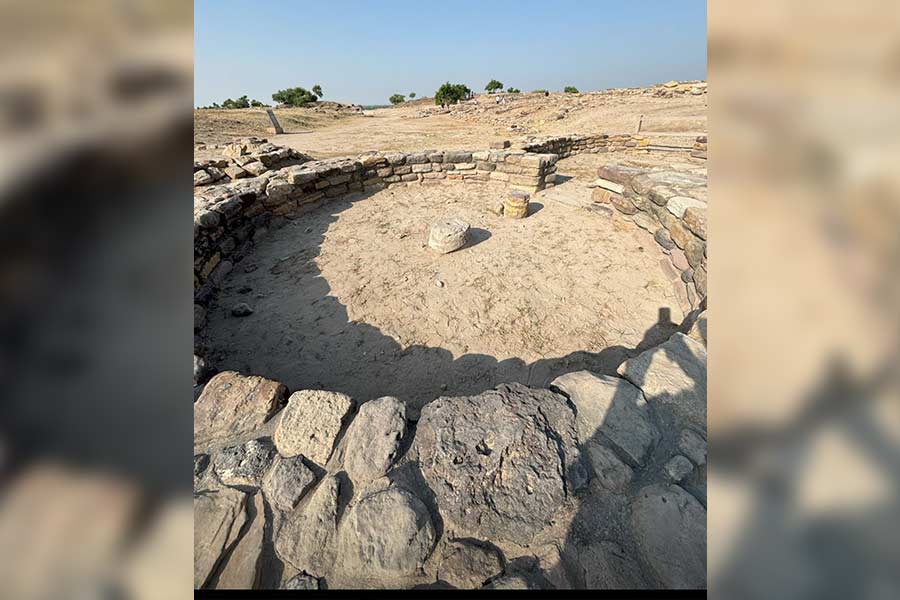
The foundation of a circular home or a Bhunga
This thriving city, with trade connections to other countries, was largely an agricultural community — even jowar fossils have been found on the site. You can also find granaries from the past — holes dug into the ground that enabled residents to store grain for long periods.
Evidence was found of a bead workshop on site – the raw materials came from as far as Egypt and Mesopotamia and bodyguards were planted nearby for security. “As the sea was close by it was easy for loading onto ships for trade,” says Mahendr. More than 850 beads from agate to jasper, were found on the site. I muse on the ships of the past that carried these treasures down the estuary to the sea, and a long voyage.
One couldn’t help but admire the ingenuity of this ancient civilisation, which built such magnificent structures using stone, without any technology — relying on mechanical ramps and animals to pull stone up to great heights — and constructed rechargeable wells from which bullocks drew water in large water bags — with the marks of ropes still visible on the sides of the wells.
Between the citadel and the middle town, there was a large open ground with brick seating for 10,000 that had been excavated. Archaeologists believed that this may have also served as a ceremonial ground or sports arena. The middle town was well planned, with streets in a grid and houses that had shops in front.
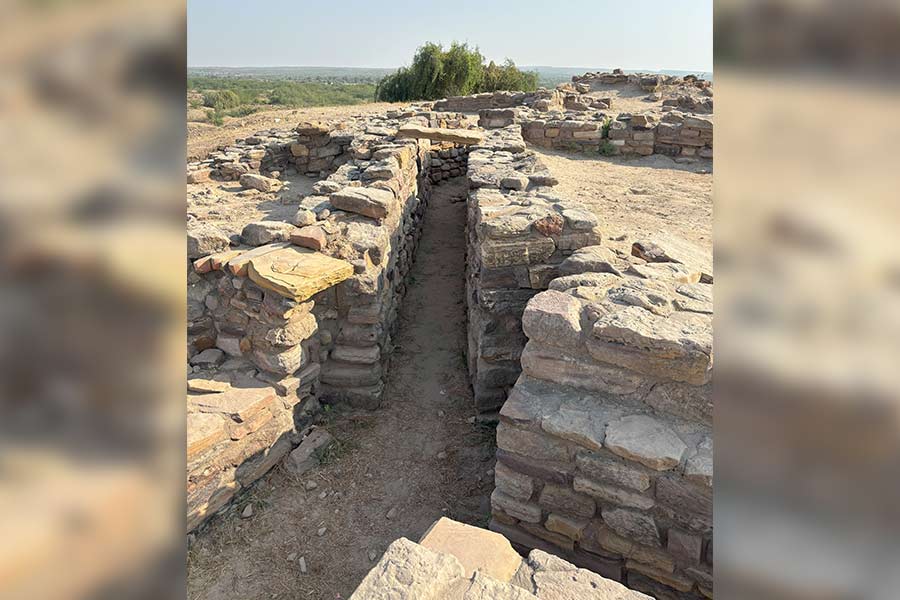
The granary with paths in between storage so that pests don’t infect the entire crop
A lot is still shrouded in mystery. A circular structure on the site is believed to be a grave or memorial, although it contained no skeletons or other human remains. Evidence of an undeciphered pictorial script was found on a signboard at the North Gate, with 10 large symbols or letters on a wooden board. Was it a welcome sign? What did it signify?
Only a fraction of the site —about 10% — had been unearthed. The city was built and destroyed seven times, and after that, it was never rebuilt. At the zenith of its power, as many as 20,000 people would have lived here. Archaeologists concluded that the scarcity of water forced the inhabitants to leave permanently.
But a walk through this ancient site was a lesson in sustainability and urban planning, developed 4,500 years ago. It also reminded one of the ephemeral nature of civilisations — their dependence on water and how they could die — especially relevant now, in times of climate change.

